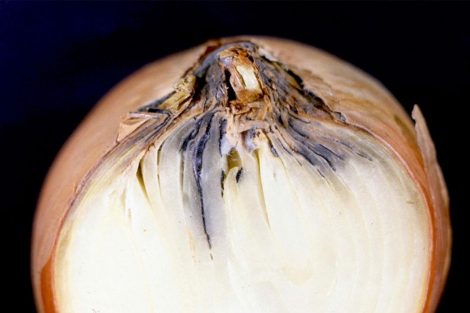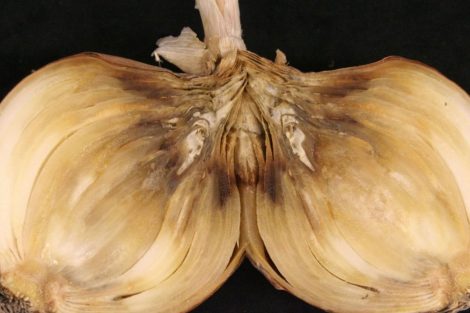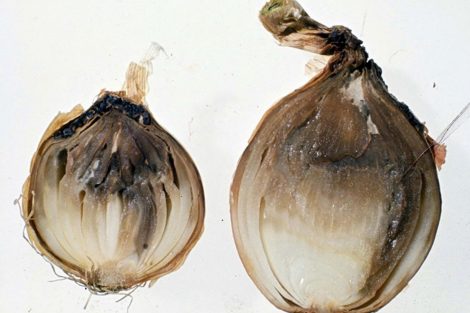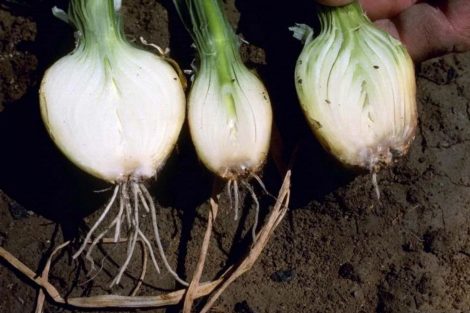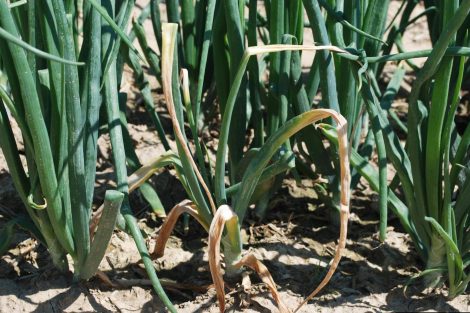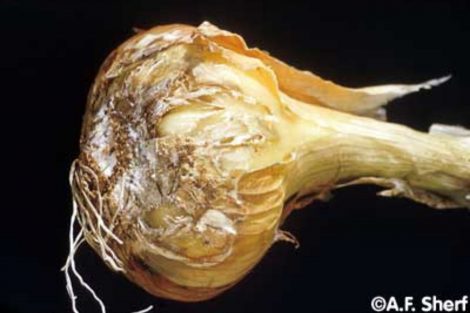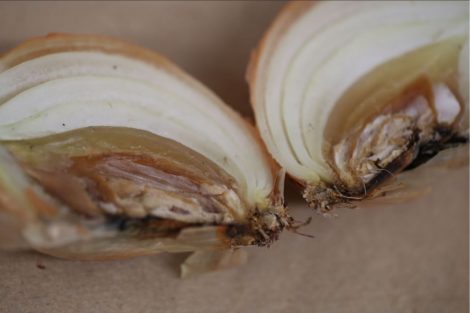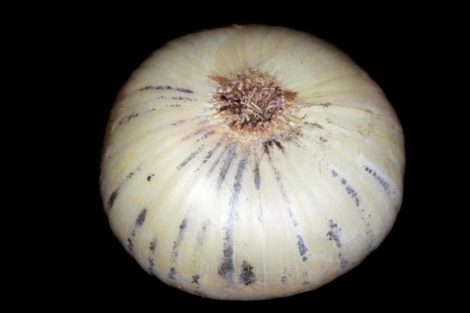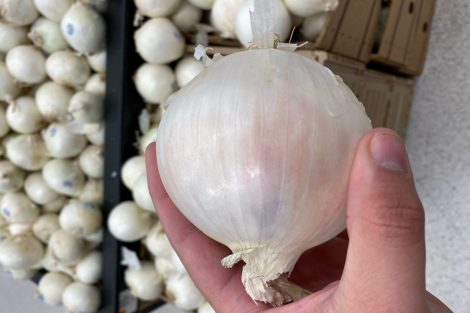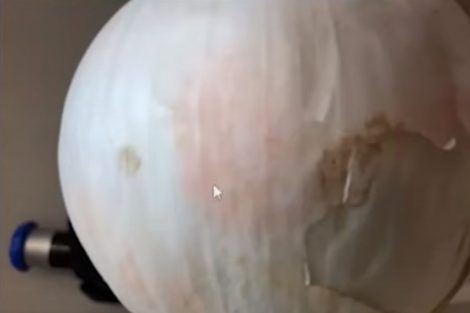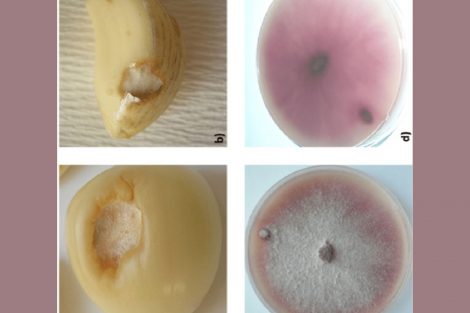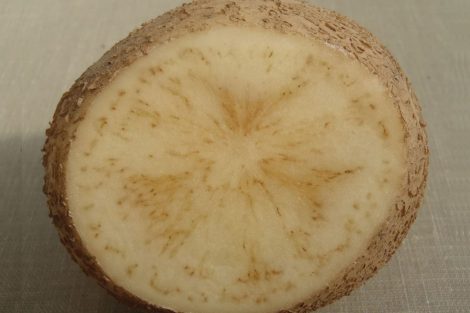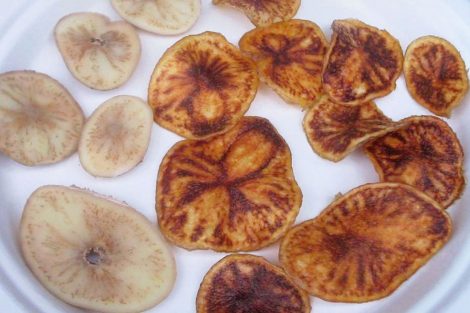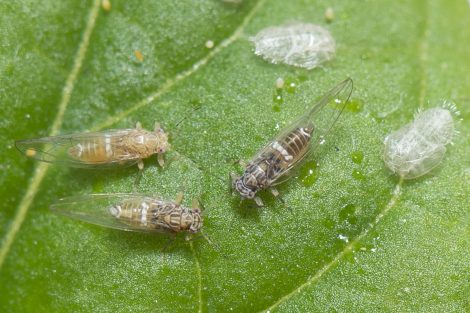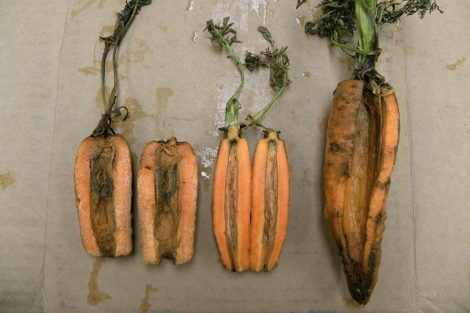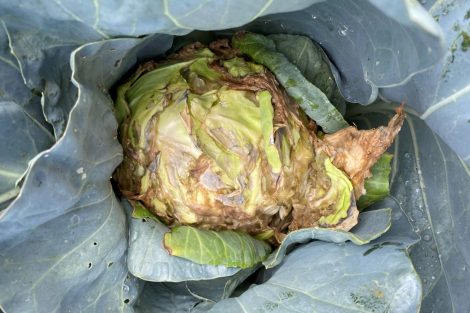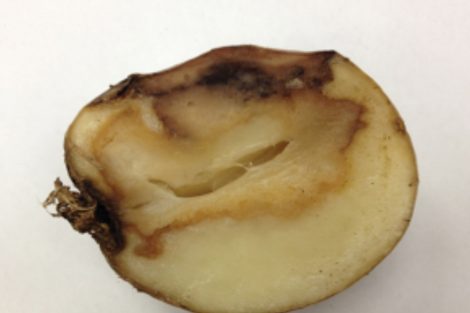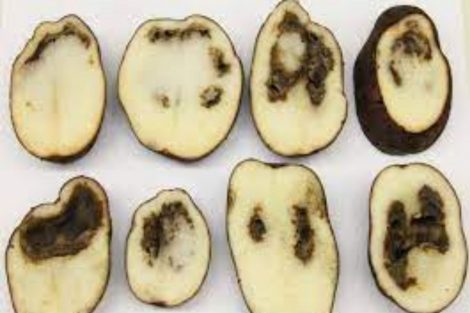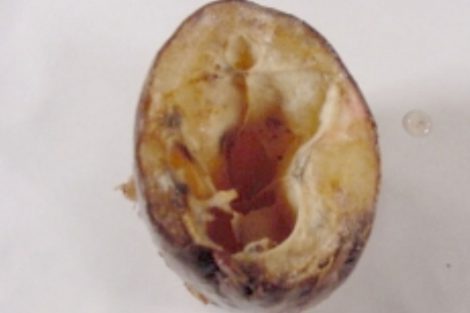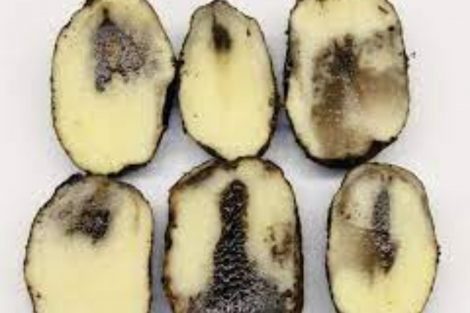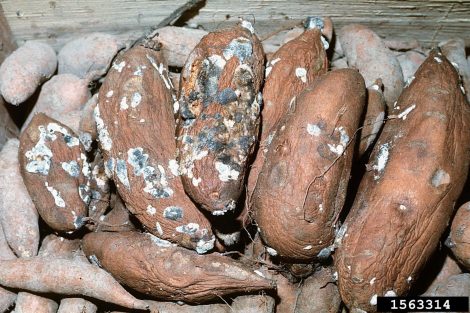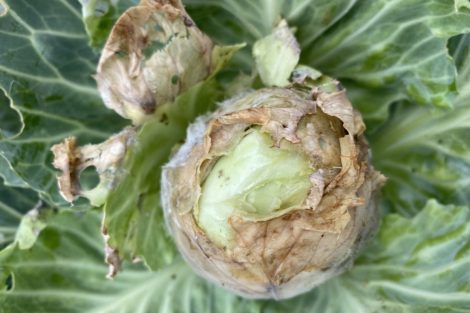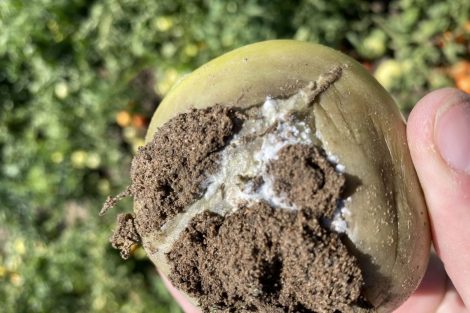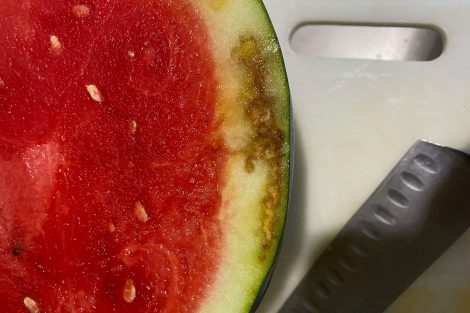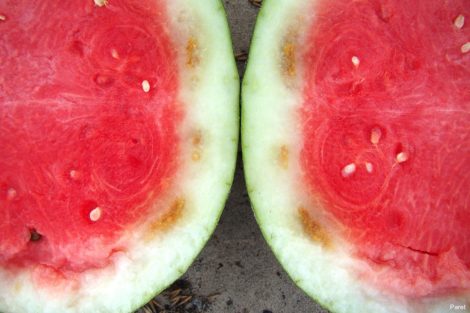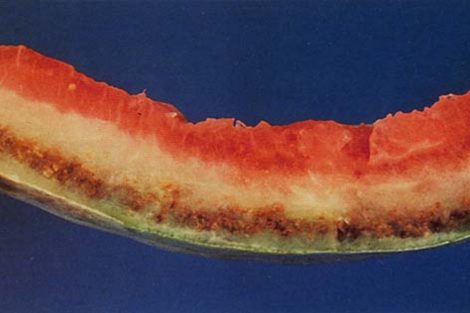Botrytis Neck Rot
Occurrence: Common
Description: Botrytis neck rot is a post-harvest storage disease. However, infection occurs in the field but remains latent. The disease is found worldwide. Yield losses can range from 30% up to 100% in severe cases. Botrytis aclada and Botrytis allii are airborne, soilborne, and seed-borne. Sclerotia (fungal survival structures) can survive on onion debris in the soil for several years. Spores can be spread by wind and rain. Infection of leaf and neck tissue occurs during moist and warm conditions but no symptoms develop (latent infection). If the neck area is still moist during harvest, the fungus colonizes the tissue and then moves into the bulb. Symptoms in bulbs are visible after 4-8 weeks in storage.
Management: There are no resistant cultivars available for Botrytis neck rot. A combination of management tools is necessary to minimize losses to neck rot. Curing onions by undercutting onions at maturity. All roots need to be severed. If it is wet during harvest artificial drying with forced, heated air (about 93°F) can be used followed by cool storage.
Fungicide Options for Commercial Onion Producers
(Late applications of fungicides such as can decrease infections especially if it is rainy during harvest)
| chlorothalonil | Bravo, Echo, Equus, Initiate |
| chlorothalonil + azoxystrobin | Quadris Opti |
| Penthiopyrad | Fontelis |
| boscalid + pyraclostrobin | Pristine |
| fluxapyroxad + pyraclostrobin | Merivon Xemium |
| cyprodinil | Vangard |
| pyrimethanil | Scala |
| pyrimethanil + fluopyram | Luna Tranquility |
| cyprodinil + fludioxonil | Switch |
| fluazinam | Omega |
| Bacillus amyloliquefaciens strain F273 | Amplitude |
| extract of Reynoutria sachalinensis | Regalia |
| hydrogen dioxide | Oxidate |
*Always read product labels and ensure safety and proper application.
Sources:
Utah Vegetable Production & Pest Management Guide, Botrytis Neck Rot
USU Extension Integrated Pest Management – Botrytis Neck Rot
Botrytis Neck Rot Fact Sheet (USU Extension)
Fusarium Basal Rot
Occurrence: Occasional
Description: Fusarium Basal Rot is caused by the fungus Fusarium oxysporum f. sp. cepae. It is a soilborne disease that is present worldwide. The disease affects all allium species but is most damaging in onion and garlic production. The fungus infects onions and garlic at any growth stage through the wounds and scars at the base of the bulb. Initial symptoms include leaf curling, yellowing, and dieback. Red-brown discoloration and rot form along the root-basal plate margin. When cut open, the bulb tissue will appear brown. Symptoms may not be visible in the field, as they tend to develop during storage. F. oxysporum f. sp. cepae overwinters in the soil as chlamydospores (thick-walled survival spores) within the soil. When temperatures reach 77-84°F, chlamydospores germinate and invade onions through existing tissue wounds. Rotational crops (corn, tomato, sunflower, oats, and sudangrass) support fungal growth but are asymptomatic.
Management: Plant cultivars that are resistant to fusarium basal rot. Consider implementing crop rotation with non-host crops for 3-4 years in infected plants. When harvesting, store onion bulbs at 39°F and relatively low humidity (70%) to prevent additional loss.
Sources:
Utah Vegetable Production & Pest Management Guide, Fusarium Basal Rot
Black Mold
Occurrence: Rare
Description: Aspergillus niger is a commonly found fungus that causes mold on many vegetables including onion. Without a microscope, the spores can be mistaken for smut another fungus that can affect onions. However, in Utah smut is rare. Aspergillus spores are airborne, soilborne, and seed-borne. The fungus can survive on plant debris. Infection usually occurs wounds in the bulb. The disease is worse under warm conditions, especially during storage. Optimum growing conditions are 82-93°F. Harvested onions should be stored at cool temperatures as soon as possible. If long-distance transport occurs under warm conditions the fungus will resume growth even if onions had been stored in cool conditions. Symptoms include discoloration in the neck area, dark lesions with spores developing under the outer scales, and general bulb rot.
Management: Avoid wounding or bruising the bulbs during harvest. Store and transport bulbs below 59°F.
Sources:
USU Extension Integrated Pest Management – Black Mold
Pink Spots on White Bulbs
Occurrence: Rare
Description: Pink spots occurring on white bulbs can be a response to bruising during harvest. It also may be a symptom of the pathogen Fusarium proliferatum. The spots are typically confined to outer dry scales. Advanced growth of Fusarium prolifeatum can potentially cause bulb rot in some cases.
Zebra Chip Disease
Occurrence: Rare
Description: Zebra chip disease is caused by the bacterium Candidatus Liberibacter solanacearum. The bacteria are transmitted when potato psyllids feed on susceptible hosts. The bacteria colonize the vascular tissue in the plant and tubers. There are no above-ground symptoms specific to zebra chip disease. When psyllids feed, they cause pink to reddish discoloration of the foliage (sometimes mistaken for nutrient deficiency). If psyllids are detected along with the discolored foliage, there is a high chance that the bacteria are present as well. Below-ground symptoms on potato tubers are only visible when they are cut. The vascular tissue in the tuber has a brown discoloration. The discoloration is even more pronounced when the potatoes are fried. The bacteria are acquired by potato psyllids and then transmitted during feeding, where they then colonize the vascular tissue in the plant and tubers. Seed pieces from infected plants either do not sprout or produce only small, weak plants.
Management: Control potato psyllids early in the season. Early detection of potato psyllids is important. Use yellow sticky cards to attract and capture adult psyllids. Monitor for psyllids on the underside of the leaves, a hand lens helps to see them. There are no resistant potato varieties. Once the potatoes are infected there is no cure.
Sources:
Utah Vegetable Production & Pest Management Guide, Zebra Chip Disease
USU Extension Integrated Pest Management – Zebra Chip Disease
Zebra Chip Disease of Potatoes Fact Sheet (USU Extension)
Bacterial Soft Rot
Occurrence: Occasional
Description: Bacterial soft rot affects many vegetables such as cabbage, carrots, onions, and potatoes. It’s caused by the bacteria Pectobacterium carotovorum. In potatoes, it can be found on seed pieces or in the soil itself. The initial symptom is tissue discoloration. It’s distinguished by the foul odor it gives off. It can spread through cracks, lenticels, and other wounds caused in the field or at harvest.
Management: When growing potatoes ensure that the seed pieces are free of rot symptoms. Consider implementing crop rotation with crops that are not susceptible to bacterial soft rot. Avoid over-irrigation. Avoid injury to the vegetables when harvesting.
Internal Heat Necrosis
Occurrence: Occasional
Description: Internal heat necrosis is not a pathogenic disease, rather a physiological condition that can occur in potatoes. Especially during high day and night temperatures in both the air and the soil. Low soil moisture is also a factor. The potato varieties Yukon Gold, Russet, Burbank, Atlantic, and Chieftan are most susceptible. The discolored core is only visible when the tubers are cut open.
Management: Avoid heat stress by providing proper nutrition to ensure a healthy canopy to shade hills and reduce temperatures. Avoid harvesting during high temperatures.
Rhizopus Storage Rot
Occurrence: Common
Description: Rhizopus is a genus of fungus that can be present in our soils. It enters fruit through wounds created by insects, weather, or mechanical damage. Many stored food products including vegetables can be susceptible.
Management: Avoid any injury to plants when they’re in the field and when they’re being harvested.
Watermelon Rind Necrosis
Occurrence: Somewhat Rare
Description: The exact cause of watermelon rind necrosis is unknown. Many bacteria species have been isolated but none have definitively linked to the symptoms. It is hypothesized that stress triggers a hypersensitive response to the bacteria being present.

